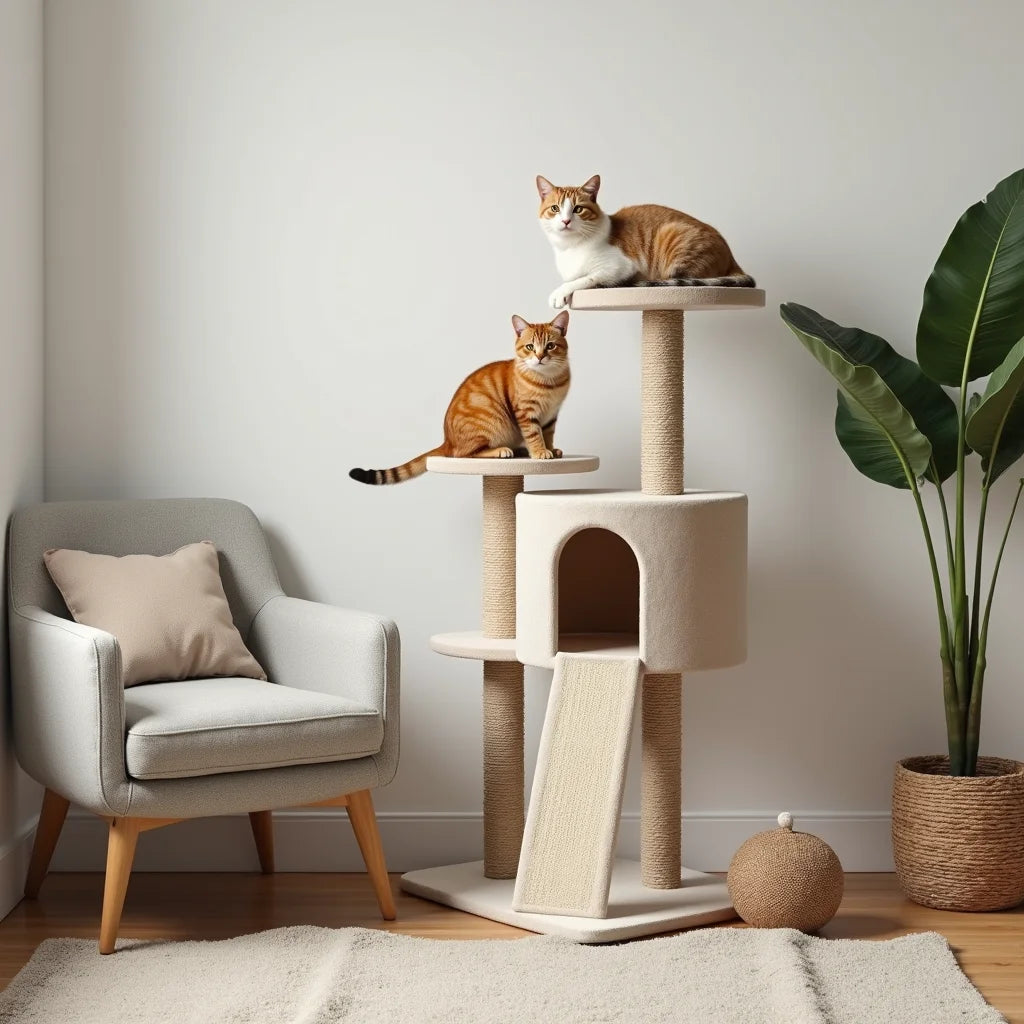
Luxury Cat Tree Buying Guide for Stylish Homeowners
Updated on: 2025-10-25
Table of Contents
- Why a luxury cat tree matters for you and your cat
-
How-To Guide: Choosing the Right Luxury Cat Tree
- Step 1: Map your space and your cat’s routine
- Step 2: Choose stable construction and safe materials
- Step 3: Match the design to your cat’s size and style
- Step 4: Plan scratching zones and durable surfaces
- Step 5: Place, anchor, and introduce it the right way
- Step 6: Keep it fresh with cleaning and quick refreshes
- Common Questions Answered About Luxury Cat Trees
If you’ve ever bought a wobbly cat tower that your cat ignored after a week, you know the struggle. A luxury cat tree solves most of those pain points. It’s built for daily use, looks like modern furniture, and actually supports your cat’s instincts to climb, scratch, and nap. In the first 100 words, let’s call it out: a luxury cat tree can be a premium cat tree or a designer cat tree—usually crafted with solid wood, real sisal rope, and stable platforms. The right pick protects your couch, enriches your cat’s day, and fits your home without shouting “pet furniture.”
How-To Guide: Choosing the Right Luxury Cat Tree
Step 1: Map your space and your cat’s routine
Start with two quick notes: where will it live and how does your cat spend their day? A corner layout near a window is ideal, but a long wall can also work—especially for a designer cat tree with a horizontal footprint. Measure ceiling height and check for baseboards or vents that might affect placement.
Next, watch your cat for a day. Do they sprint and leap, or are they a careful climber? Do they nap high or low? The more you match the tree to your cat’s routine, the more they’ll use it. If you have two or more cats, plan for at least two lounging spots and one more platform than the number of cats to reduce turf scuffles.
Step 2: Choose stable construction and safe materials
Stability is non-negotiable. Look for a heavy base, wide footprint, and hardware that locks tight. The best luxury cat tree options rely on solid wood or thick plywood for load-bearing pieces, with real sisal rope for scratching posts. Metal fasteners should be sturdy, and platforms should not flex under weight.
Skip thin fabrics and cardboard cores; they wear out fast. If you see “luxury cat tree with solid wood and sisal rope,” that’s a strong sign of long-term durability, especially for larger breeds. Bonus points for rounded edges, nontoxic finishes, and removable, washable cushion covers.
Step 3: Match the design to your cat’s size and style
Cats come in all sizes—and so should your tree. If you share your home with big cats, look for a luxury cat tree for large cats with platforms at least as long as your cat from nose to base of tail. Tall posts (24 inches or more) let them stretch fully when scratching. For kittens or cautious climbers, choose graduated step heights to build confidence.
Style matters too. A modern cat furniture aesthetic—neutral wood tones, minimal silhouettes, and fabric textures that match your home—can make the piece feel like it belongs. Whether you lean toward a sleek designer cat tree or a cozier cat condo with enclosed nooks, make sure the look aligns with your space so you’ll love seeing it every day.
Step 4: Plan scratching zones and durable surfaces
Scratching is a need, not a habit. Offer a mix of vertical and angled scratching posts wrapped in natural sisal rope, which holds up better than carpet. If you can, choose replaceable scratch posts to extend the life of your investment. The best premium cat tree designs also add variety: sisal on the main posts, a felt or woven panel for friction, and hardwood edges that resist fraying.
For lounging, look for deep beds with bolsters and washable covers. Platforms should be wide and padded, and stairs or ramps can help senior cats access top perches without jumps.
Step 5: Place, anchor, and introduce it the right way
Placement can make or break adoption. Put the tree where your cat already hangs out—near a bright window, beside your desk, or in the living room. Avoid tucking it away in a quiet room they rarely visit. If the model allows, anchor it to the wall for extra stability, especially in multi-cat homes.
To encourage use, start with scent. Rub a favorite blanket on the perches and add a sprinkle of catnip or a silvervine toy. Feed treats on the lower platforms, then move them higher day by day. Praise curiosity and ignore hesitation. Most cats climb fully within a week when the experience feels safe and rewarding.
Step 6: Keep it fresh with cleaning and quick refreshes
Routine care keeps your luxury cat tree looking new. Vacuum fur weekly with a brush attachment. Spot-clean wood with a lightly damp cloth and dry immediately. Wash fabric covers as directed. Replace worn sisal wraps or swap in a new scratch post section when grooves flatten out.
Rotate toys on the tree every couple of weeks. A small change—like adding a teaser wand to a lower perch—can spark new interest and keep cats engaged.
Ready to see what’s possible? Explore beautifully built options and get a feel for sizing and finishes right here: Shop Meowhaus. For a broader view of available styles and materials, browse All collections.
Common Questions Answered About Luxury Cat Trees
Are luxury cat trees worth the price?
Often, yes—if you choose thoughtfully. A well-made luxury cat tree is engineered for daily climbing and scratching, using solid wood, real sisal, and secure fasteners. It tends to last longer, feel steadier, and look better than budget towers. That longevity and stability can reduce replacements, protect your sofa, and keep your cat more active. In short: you pay once for materials and design that perform every day.
What is the best luxury cat tree for multiple cats?
Look for a layout with several entrances and exits, at least one perch per cat, and a base that doesn’t wobble when two cats jump at once. Tiered platforms that aren’t directly stacked reduce staring contests, and two scratch zones on different levels help prevent resource guarding. If your cats vary in size, choose extra-wide perches and a tall post for the largest cat to stretch comfortably.
How tall should a luxury cat tree be?
It depends on your ceilings and cat confidence. Many homes do well with trees between four and six feet. Taller models create vertical territory, but only if they’re steady and offer step-like access. For kittens, seniors, or cautious climbers, choose moderate height with gradual steps and add height later if they crave more elevation.
What materials last the longest?
Solid wood or thick plywood for the structure, natural sisal rope for scratching posts, and performance fabrics or washable covers for perches. Avoid thin particleboard, loose carpeting, and weak connectors. If a model specifies “luxury cat tree with solid wood and sisal rope,” that’s a reliable durability combo.
How do I get my cat to stop scratching the couch and use the tree?
Make the tree the easy, rewarding choice. Place a sisal-wrapped post where your cat likes to scratch, and reward any use with calm praise or treats. Use double-sided furniture tape during the transition and keep the tree near social spots so it becomes part of your cat’s daily route. Consistency works better than scolding.
Is a cat condo better than open platforms?
Neither is “better” across the board. A cat condo offers enclosed security for naps, while open platforms are great for supervising the room and sunbathing. Many luxury designs mix both, giving your cat options based on mood and temperature.
If you have questions about sizing or setup, reach out anytime via Contact. And if you’re planning delivery details, check the current Shipping policy before you order.

Sage is a design-obsessed cat parent focused on turning “pet gear” into purposeful décor. At MeowHaus, Sage covers styling guides, enrichment setups, and buyer’s tips to help you ditch carpet towers for furniture-grade pieces. Off the blog, you’ll find Sage scouting textures, testing scratchables, and sipping espresso under a sun-soaked window ledge.
